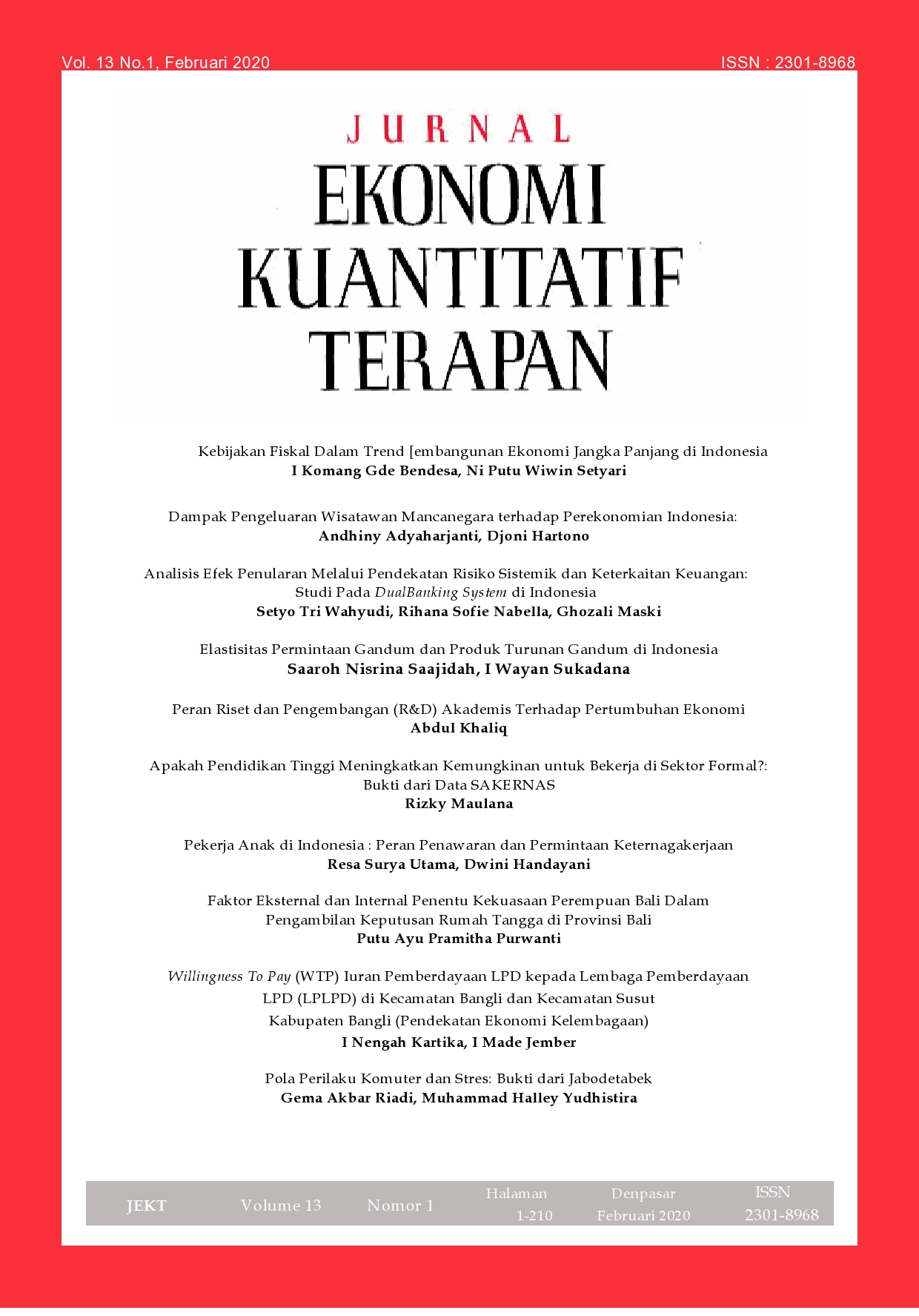Analisis Efek Penularan Melalui Pendekatan Risiko Sistemik dan Keterkaitan Keuangan
Studi Pada Dual Banking System di Indonesia
Abstract
Banking sector plays an important role in the economy. The emergence of the dual banking system era has become an alternative source of financing aside from conventional banks in supporting economic growth. Banks are also expected to be able to manage their risks well, one of them is systemic risk. This risk arises due to the contagion effect and is compounded by the financial linkages between banks. Research aims to analyze the contagion effect through a systemic risk approach and financial linkage on the dual banking system in Indonesia. This study uses the Conditional Value at Risk (CoVaR) by Adrian and Brunnermeier (2009) with a sample of 8 Islamic banks and 7 conventional commercial banks in Indonesia from January 2012 to December 2018. The results obtained are systemic risk and financial linkage able to explain the contagion effect in a banking system. High systemic risk and high financial linkage can drive negative externalities towards other institutions in the banking system, in this case transmitting risks.
Keywords: contagion effect, systemic risk, financial linkage, dual banking system
Downloads
References
Acharya, Viral V.; Pedersen, Lasse H.; Philipon, Thomas dan Richardson, Mathew. 2010. Measuring Systemic Risk. Working paper The 17th Duvronik Economic Conference.
Adrian, T. & Brunnermeier. 2009. CoVaR. Princeton: Princeton University, Department of Economics, Bendheim Center for Finance.
Ahmed, H. 2002. A Microeconomics Model of an Islamic Bank. Jeddah: Islamic Research and Training Institute, Islamic Development Bank Group.
Ayomi, Sri dan Hermanto, Bambang. 2013. Mengukur
Risiko Sistemik dan Keterkaitan Finansial Perbankan di Indonesia. Buletin Ekonomi Moneter dan Perbankan.
Bank Indonesia. 2018. Definisi dan Pentingnya SSK. https://www.bi.go.id/id/perbankan/ssk/ikhtisar/definisi/Contents/Default.aspx. Diakses 21 April 2019.
Cai, Jian; Eidam, Frederik, Saunders, Anthony & Steffen, Sascha. 2018. Syndication, Interconnectedness, and Systemic Risk. Journal of Financial Stability, 34, 105-120.
De Bandt, O.; Hartman P. & Peydro, JL. 2010. Systemic Risk in Banking an update. Oxford Habook of Banking, pp 634-664.
Derbali, A. & Hallara, S. 2015. Systemic Risk of European Financial Institutions: Estimation and Ranking by the Marginal Expected Shortfall. Research in International Business and Finance.
Drakos, A. A & Kouretas, G. P. 2015. Bank Ownership, Financial Segments and the Measurement of Systemic Risk: An Application of CoVaR. International Review of Economics and Finance, 40, 127-140.
Hasan, Zubair & Kayed. 2016. Evolution of Islamic Economics: Definition, nature, methodology, problems and challenges. MPRA Paper.
Hasan, Maher & Dridi, Jemma. 2010. The Effect of the Global Crisis on Islamic and Conventional Banks: A Comparative Study. IMF Working Paper WP/10/201.
Huang, W. Q; Zhuang, X. T.; Yao, S. & Uryasev, S. 2016. A Financial Network Perspective of Financial Institutions’ Systemic Risk Contributions. Physica A.
Juhro, S.M; Darsono, Syarifuddin, M. & Sakti, Ali. 2018. Kebijakan Moneter Syariah dalam Sistem Keuangan Ganda Teori dan Praktek. Jakarta: Tazkia Publishing.
Muharam, H. & Erwin. 2017. Measuring Systemic Risk of Banking in Indonesia: Conditional Value at Risk Model Application. Jurnal Ilmu Ekonomi, 6, 301-318.
Roengpitya, R & Rungcharoenkitkul, P. 2010. Measuring Systemic Risk and Financial Linkages in the Thai Banking System. Bangkok: Journal Bank of Thailand.
Simorangkir, I. 2006. The Openness and Its Impact to Indonesia Economy: A SVAR Approach. Jakarta: Center for Central Banking Education and Studies, Bank Indonesia.
Zebua, Alfredo. 2011. Analisis Risiko Sistemik Perbankan Indonesia. Bogor: Institut Pertanian Bogor.
Zhou, C. 2010. Are Banks Too Big to Fail? Measuring Systemic Imprtance of Financial Institutions. International Journal of Central Banking, Vol. 16, 4, 205-250.




















